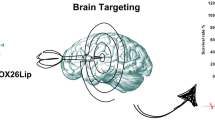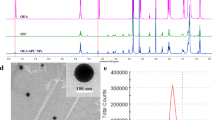Abstract
Purpose. Cytidine-5′-diphosphate choline (CDPc) was encapsulated in long-circulating unilamellar vesicles (SUVs) to improve the drug's biological effectiveness.
Methods. SUVs made up of diaplmitoylphosphatidylcholine/diaplmitoylphosphatidylserine/ cholesterol (7:4:7 molar ratio) and 8 mol % of ganglioside GMl were prepared by extrusion through polycarbonate filters (mean diameter 50 nm). The formulation effectiveness was evaluated by an in vivo model of cerebral ischemia on Wistar rats.
Results. The enhanced delivery of CDPc into the brain improved the therapeutic effectiveness of the drug. CDPc-loaded SUVs improved the survival rate of ischemized and reperfused Wistar rats (320-350 g) by -66% compared with the free drug. Liposome formulation was also able to effectively protect the brain against peroxidative damage caused by post-ischemic reperfusion. SUVs lowered the conjugated diene levels of the cerebral cortex. The liposomal delivery system did not alter the distribution patterns in the various cerebral lipid fractions of the drug, radiolabeled with 14C-CDPc.
Conclusions. CDPc-loaded SUVs were able to protect the brain against damage induced by ischemia. A possible clinical application is envisaged.
Similar content being viewed by others
REFERENCES
E.A. Neuwelt and P.A. Barnett. Blood-brain barrier disruption in the treatment of brain tumors: animal studies. In E.A. Neuwelt (ed.), Implications of the blood-brain barrier and its manipulation, Plenum Medical Book Company, New York, vol. 2 Clinical Aspects, 1991, pp. 727–739.
M.W. Brightman and R.D. Broadwell. The morphological approach to the study of normal abnormal brain permeability. Adv. Exp. Med. Biol. 69:41–54 (1976).
A. Laham, N. Claperon, J.J. Durussel, E. Fattal, J. Delattre, F. Puisieux, P. Couvreur, and P. Rossingnol. Liposomally-entrapped ATP: Improved efficiency against experimental brain ischemia in the rat. Life Sci. 40:2011–2016 (1987).
G. Arienti, L. Corazzi, P. Mastrofini, I. Montanini, B. Tirillini, and G. Porcellati. Involvement of CDP-choline in phospholipid metabolism of brain tissue in vitro. J. Biochem. 28:39–45 (1979).
J. Agut, E. Font, A. Sacristan, and J.A. Ortiz. Bioavailability of methyl 14C-CDP choline by oral route. Arzneim-Forsch Drug Res. 33:1045–1071 (1983).
C. La Rosa, D. Grasso, M. Fresta, C. Ventura, and G. Puglisi. Phospholipid vesicles as drug delivery system. Part I. Interaction of Cytidine-5′-diphosphate choline with charged and zwitterionic phospholipids. Thermochim. Acta 195:139–148 (1992).
C. La Rosa, D. Grasso, M. Fresta, C. Ventura, and G. Puglisi. Phospholipid vesicles as drug delivery system. Part II. A study on kinetic fusion between vesicles containing CDP-choline and dipalmitoylphosphatidylcholine vesicles. Thermochim. Acta 198:181–190 (1992).
G. Puglisi, M. Fresta, C. La Rosa, C.A. Ventura, A.M. Panico, and G. Mazzone. Liposomes as a potential drug carrier for citicoline (CDP-choline) and the effect of formulation conditions on encapsulation efficiency. Pharmazie 47:211–215 (1992).
M. Fresta, G. Puglisi, A.M. Panico, S. Di Marco, and G. Mazzone. CDP-choline entrapment and release from multilamellar and reverse-phase evaporation liposomes. Drug. Dev. Ind. Pharm. 19:559–585 (1993).
M. Fresta, G. Puglisi, C. Di Giacomo, and A. Russo. Liposomes as in vivo carrier for CDP-choline. Effects on rat cerebral postischemic reperfusion. J. Pharm. Pharmacol. 46:974–981.
S. Benita, P.A. Poly, F. Puisieux, and J. Delattre. Radiopaque liposomes: effect of formulation conditions on encapsulation efficiency. J. Pharm. Sci. 73:1751–1754.
M.A. Schwartz, and H.M. McConnell. Surface areas of lipid membranes. Biochemistry 17:837–840 (1978).
R.O. Recknagel and E.A. Glende. Spectrophotometric determination of lipid conjugated dienes. In L. Packer (ed.), Methods in Enzymology. Academic Press, New York, 1984, vol. 105, pp. 331–337.
C. Long and D.A. Staples. Chromatographic separation of brain lipids. Biochem. J. 78:179–185 (1961).
G. Poste. Liposome targeting in vivo: problems and opportunities. Biol. Cell 47:19–37 (1983).
A. Gabizon and D. Papahadijopoulos. Liposome formulations with prolonged circulation time in blood and enhanced uptake by tumors. Proc. Natl. Acad. Sci. 85:6949–6953 (1988).
U. Ito, T. Yamaguchi, H. Tomita, O. Tone, T. Shishido, H. Hayashi, and M. Yoshida. Maturation of ischemic injuries observed in mongolian gerbils: introductory remarks. In U. Ito, T. Kirino, T. Kuroiwa, and I. Klatzo (eds.), Maturation phenomenon in cerebral ischemia, Springer-Verlag, Germany, 1992, pp. 1–13.
L.D. Mayer, M.J. Hope, P.R. Cullis, and A.S. Janoff. Solute distribution and trapping efficiencies observed in freeze-thawed multilamellar vesicles. Biochim. Biophys. Acta 817:193–196 (1985).
M.J. Hope, M.B. Bally, L.D. Mayer, A.S. Janoff, and P.R. Cullis. Generation of multilamellar and unilamellar phospholipid vesicles. Chem. Phys. Lipids 40:89–107 (1986).
B.K. Siesjö and M.L. Smith. The biochemical basis of ischemic brain lesion. Arzneim. Forsch. 41:288–292 (1991).
A. Vanella, Sorrenti V., Castorina C., Campisi A., Di Giacomo C., Russo A., and Perez-Polo. Lipid peroxidation in rat cerebral cortex during post-ischemic reperfusion: effect of exogenous antioxidants and Ca+ +-antagonist drugs. Int. J. Devl. Neurosc. 10:75–80 (1992).
Author information
Authors and Affiliations
Rights and permissions
About this article
Cite this article
Fresta, M., Wehrli, E. & Puglisi, G. Enhanced Therapeutic Effect of Cytidine-5′ -Diphosphate Choline when Associated with GM1 Containing Small Liposomes as Demonstrated in a Rat Ischemia Model. Pharm Res 12, 1769–1774 (1995). https://doi.org/10.1023/A:1016234226404
Issue Date:
DOI: https://doi.org/10.1023/A:1016234226404




